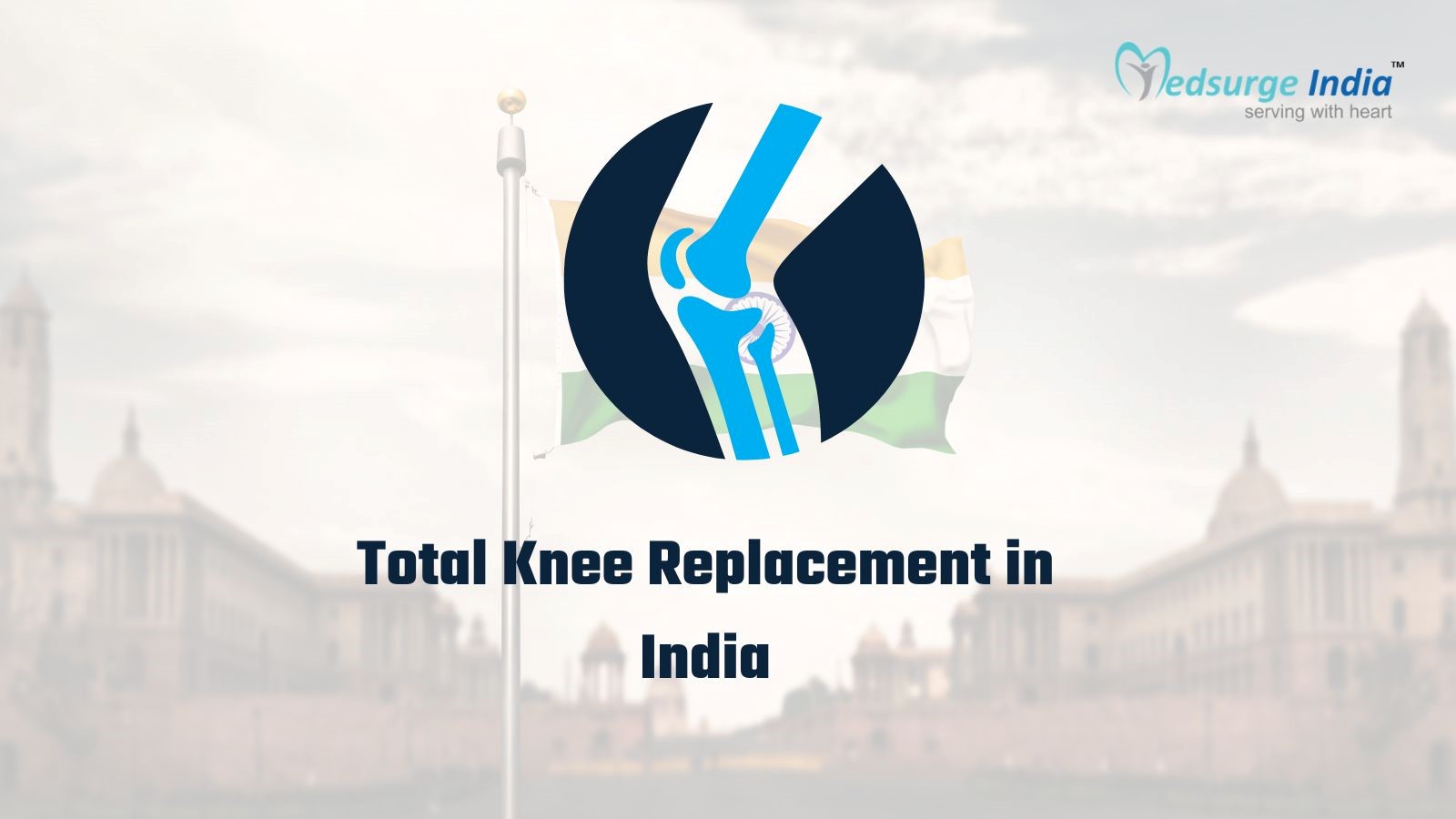Everything About Total Knee Replacement in India
Total Knee Replacement (TKR) surgery, also known as knee arthroplasty, is a medical procedure that aims to relieve pain and improve knee function for individuals suffering from severe knee joint problems. India has emerged as a leading destination for knee replacement surgeries, offering high-quality healthcare services at a fraction of the cost compared to many Western countries. In this blog, we will provide a step-by-step guide to help you understand India’s total knee replacement surgery procedure and the different knee surgery types available.
What is Knee Replacement Surgery?
The components of damaged or worn-out knee joints are replaced during knee replacement surgery. The surgery might make the knee more operating and less challenging. Plastic and metal components are used during surgery to substitute damaged bone and cartilage.
To determine if you need a knee replacement, a surgeon will assess the strength, stability, and range of motion of your knee. The extent of the damage can be determined with the help of X-rays. The optimal replacement joints and surgical techniques for you are contingent on your age, weight, level of exercise, the size and shape of your knees, and your general health.
Additional Knee replacement surgery cost in India is in high demand as the price for treatment is much lower compared with other well-developed nations. The surgeons and specialists present in India are well known as some of the best in the world. Patients from all over the globe come to India to have treatment in India as the nation is not all known for having the best orthopedic surgeons but also due to a friendly budget as compared with devolved countries.
Types of Knee Surgery
Knee surgery types encompass a range of procedures designed to address various knee-related issues, from injuries to degenerative conditions. Here are some common knee surgery types:
- Arthroscopy
Arthroscopy is a minimally invasive procedure where a small camera, called an arthroscope, is inserted into the knee joint through tiny incisions. Surgeons use this technique to diagnose and treat a variety of knee problems, such as torn ligaments, damaged cartilage, and inflamed synovium. Arthroscopy is less invasive, resulting in shorter recovery times compared to open surgery.
- Partial Knee Replacement
A partial knee replacement can be conducted when the knee joint is only injured in one area. This procedure involves replacing the damaged portion of the knee with a prosthetic implant while preserving the healthy portions of the joint. It is a less extensive surgery compared to total knee replacement.
- Total Knee Replacement (TKR)
Total Knee Replacement, also known as knee arthroplasty, is a surgical procedure where the entire knee joint is replaced with an artificial prosthesis. This is typically recommended for individuals with severe knee arthritis or joint damage. TKR aims to relieve pain and restore function, providing long-term relief for patients with advanced knee conditions.
- ACL Reconstruction
Anterior Cruciate Ligament (ACL) reconstruction is a common procedure for athletes and individuals with ACL injuries. The torn ACL is replaced with a graft (tendon) from the patient’s own body or a donor. This surgery helps stabilize the knee and restore proper function.
- Meniscus Repair
The menisci are cartilage discs in the knee that act as shock absorbers. Meniscus tears are common knee injuries and can often be repaired through arthroscopic surgery. In cases where repair is not possible, a partial meniscectomy may be performed to remove the damaged portion.
- Lateral Release
Lateral release surgery is performed to correct issues with the patella (kneecap) alignment. It involves releasing tight or misaligned structures on the outside of the knee to alleviate patellar tracking problems and reduce knee pain.
- Osteotomy
Knee osteotomy is a procedure to realign the bones in the knee joint. It is typically used to treat individuals with knee arthritis or deformities. By repositioning the bones, the pressure on the damaged area is reduced, providing pain relief and delaying the need for knee replacement.
- Revision Knee Surgery
This surgery is performed when a prior knee replacement has failed or complications have arisen. It involves the removal or replacement of the original prosthetic components to restore knee function.
Each of these knee surgery types is tailored to address specific knee conditions and issues. The choice of surgery depends on the patient’s diagnosis, the severity of the problem, and the orthopedic surgeon’s recommendations. Patients should consult with their healthcare provider to determine the most suitable treatment option for their individual case.
Knee Replacement Surgery Procedure
When it comes to healthcare excellence, the best orthopedic hospitals in India stand out as world-class institutions. These medical centers are renowned for their cutting-edge treatments and highly skilled orthopedic surgeons. India’s reputation as a medical hub attracts patients from around the globe seeking top-notch orthopedic care. Here is the step-by-step guide for Total Knee Replacement Surgery In India.
- Consultation and Evaluation
The first step in the journey to a total knee replacement in India begins with a consultation with an orthopedic specialist. During this initial meeting, the surgeon will assess your knee condition, discuss your medical history, and conduct necessary diagnostic tests, such as X-rays or MRIs. This evaluation is crucial for determining the suitability of the surgery.
- Pre-operative Preparations
Once your surgeon confirms that a knee replacement is the best course of action, you will undergo pre-operative preparations. This includes a thorough medical examination to ensure you are in optimal health for the surgery. Your medical team will also discuss any necessary lifestyle modifications, medications, or physical therapy to prepare you for the procedure.
- Anesthesia
You will receive anesthesia on the day of the surgery to ensure you are relaxed and pain-free throughout the process. Typically, patients can choose between general anesthesia (where you are completely asleep) or regional anesthesia (where only the lower half of your body is numbed).
- Surgical Procedure
The knee replacement surgery procedure itself involves several key steps:
- Incision: The surgeon makes an incision over the knee to access the joint.
- Reshaping Bones: Damaged portions of the knee joint are carefully removed.
- Implant Placement: Artificial knee components (implants) are securely attached to the thigh bone, shin bone, and knee cap.
- Testing and Alignment: The surgeon ensures proper alignment and functionality of the knee implant.
- Closure: The incision is closed with stitches or staples.
- Post-operative Recovery
After the surgery, you will be transferred to a recovery room, closely monitored by medical staff. Physical therapy and rehabilitation play a vital role in the recovery process. Your healthcare team will guide you through exercises to regain strength and mobility in your new knee joint.
- Post-operative Care
Following discharge from the hospital, you will continue rehabilitation and follow-up appointments with your orthopedic surgeon. Pain management, wound care, and adherence to prescribed medications are essential during this phase.
Conclusion
Total Knee Replacement Surgery in India has gained popularity due to its affordability and the availability of skilled orthopedic specialists. Understanding the knee replacement surgery procedure and the different knee surgery types is crucial for individuals considering this treatment option. Consult with a qualified orthopedic surgeon in India to discuss your specific case, determine the most suitable approach, and embark on the path to improved knee health and mobility.



